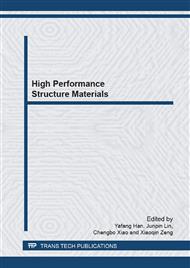[1]
J.R. Davis (Ed. ), Directionally solidified and single crystal superalloys. Heat Resistant Materials — ASM Specialty Handbook, ASM International, Materials Park, OH, 1997, p.255.
Google Scholar
[2]
Fuchs GE. Improvement of creep strength of a third generation single-crystal Ni-base superalloy by solution heat treatment. Journal of Materials Engineering and Performance 2002; 11(1): 19-25.
DOI: 10.1007/s11665-002-0003-5
Google Scholar
[3]
Fuchs GE. Solution heat treatment response of a third generation single crystal Ni-base superalloy. Materials Science and Engineering A 2001; 300: 52-60.
DOI: 10.1016/s0921-5093(00)01776-7
Google Scholar
[4]
Sajjadi SA, Zebarjad SM, Guthrie RIL, Isac M. Microstructure evolution of highperformance Ni-base superalloy GTD-111 with heat treatment parameters. Journal of Materials Processing Technology 2006; 175: 376-81.
DOI: 10.1016/j.jmatprotec.2005.04.021
Google Scholar
[5]
He LZ, Zheng Q, Sun XF, Guan HR, Hu ZQ, Tieu AK, et al. Effect of heat treatment on microstructures and tensile properties of Ni-base superalloy M963. Materials Science and Engineering A 2005; 398: 128-36.
DOI: 10.1016/j.msea.2005.03.021
Google Scholar
[6]
Hu ZQ, Liu LR, Jin Tao, Sun XF. Development of the Ni-Base Single Crystal Superalloys. ACTA AERONAUTICA ET ASTRONAUTICA SINICA 2005; Vol. 31, No. 3: 1-7.
Google Scholar
[7]
Li ping, Li SS, Han YF. Influence of solution heat treatment on microstructure and stress rupture properties of a Ni3Al base single crystal superalloy IC6SX. Intermetallics 19(2011) : 182-186.
DOI: 10.1016/j.intermet.2010.08.019
Google Scholar
[8]
Caron P., Khan T. Evolution of Ni-base superalloys for single crystal gas turbine blade applications[J]. Aerosp. Sci. Technol., 1999(3): 513-532.
DOI: 10.1016/s1270-9638(99)00108-x
Google Scholar
[9]
S.R. Hegde, R.M. Kearsy, J.C. Beddoes. Designing homogenization-solution heat treatments for single crystal superalloys. Materials Science and Engineering A 527 (2010) 5528-5538.
DOI: 10.1016/j.msea.2010.05.019
Google Scholar
[10]
Caron P., Henderson P. J., Khan T. On the effects of heat treatments on the creep behavior of a single crystal superalloy[J]. Scripta Metallurgical, 1986, 20: 875-880.
DOI: 10.1016/0036-9748(86)90458-8
Google Scholar
[11]
Koji Kakehim, Mater. Trans., JIM 40 (1999) 159–167.
Google Scholar
[12]
Li ping, Li SS, Han YF. Effect of Heat Treatment on Microstructure and Stress Rupture Properties of a Ni3Al Base Single Crystal Alloy IC6SX. Cailiaogongcheng 2009; Supplement: 131-135.
DOI: 10.1016/j.intermet.2010.08.019
Google Scholar
[13]
Muller L, Glatzel U, Feller-kniepmeier M. Modlingthermal Misfit Stresses in Mickel-Base Superalloys Containing Highvolume Fraction Phase[J]. Acta Metal Mawr, 1992, 40(6): 1321.
DOI: 10.1016/0956-7151(92)90433-f
Google Scholar
[14]
P Caron and T Khan. Material Science and Engineering, 1983, 61: 173.
Google Scholar


